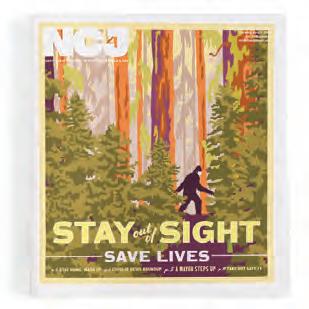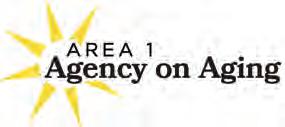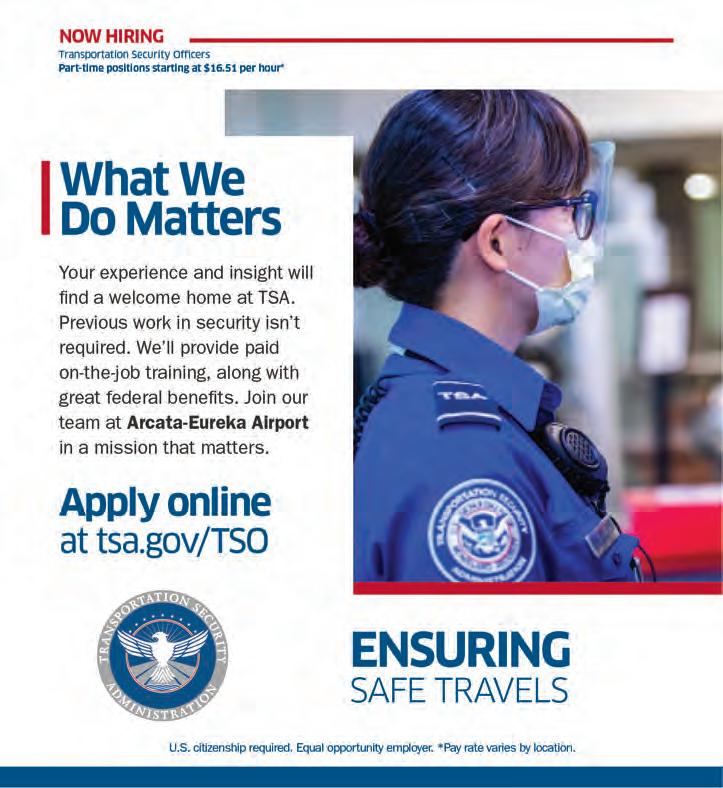
15 minute read
On The Cover
Saturday Morning Shots
RN’s Tina Wood, left, and Tina Morais load does of Pfizer COVID-19 vaccine into syringes on March 28 at the Pacific Union School campus in Arcata. The clinic was aiming to vaccinate 1,500 people.
Advertisement
Inside Mad River Community Hospital’s mass vaccination clinic
By Linda Stansberry
newsroom@northcoastjournal.com
Photos by Mark McKenna
The vaccine clinic starts at 9 a.m. By 8:45 a.m. the lines stretch from the breezeway of Pacific Union School’s main building in Arcata all the way through the parking lot, then the adjacent parking lot, to Janes Road. A young woman with blonde hair stands just inside the school’s fence, her arms crossed against the early spring chill. The morning is overcast, the sky the color of cement. A slightly harried-looking volunteer wearing a white Rotarian shirt is directing traffic at the entrance, helping people with mobility issues pull around to the back of the building, where staff with the Area 1 Agency on Aging wait to assist. A small boy wearing a Mario costume clings to his mother’s hand. The mood in the crowd is subdued, anticipatory, its masked participants not talking to one another but watching the action at the front of the line where, in the grade school’s breezeway, staff with Mad River Community Hospital bustle back and forth. There is an atmosphere of excitement mixed with slight disbelief. For many, today is the day they’ve been thinking about for more than a year, the day they can take that first necessary step toward to pre-pandemic life.
Dennis Chase, 68, and his daughter Sara Gossi, 41, both of Fortuna, stand in the shorter “second shot” line, waiting for their chance to get to the front and receive their second and final jab of the Pfizer vaccine. They were alerted to the Mad River vaccination clinic by Gossi’s inlaws. Chase is a rancher, Gossi a grocery store worker.
Next to them, Leena Dallasheh, an associate professorat Humboldt State University, says she got her first shot at a College of the Redwoods clinic.
“I’m really happy to be finally getting the shot,” she says, saying there was some confusion about whether she and her colleagues were eligible but it was resolved.
At the head of the line, Jacqueline


Jennifer Price put a Band-Aid over the injection site of one of an expected 1,500 people to get a COVID-19 vaccine at Pacific Union School in Arcata on March 28.
Martin and hospital staff are walking back and forth between the waiting crowd and a row of copy machines sitting on folding tables in the breezeway. Martin, quality team specialist and IT point of care trainer at Mad River, answers questions as she buzzes down the line, handing out clipboards with registration paperwork, taking IDs and insurance cards to copy.
“If I have an appointment, do I have to stand in this line?” asks one person.
“I have my mom’s insurance card, is that OK?” asks a college-aged young man.
No problem, Martin says.
“I don’t have any insurance,” says another young man.
By the end of the day, Martin and the other 44 hospital staff members will have helped administer 1,484 doses of Pfizer and Moderna vaccines, with Martin ensuring patient information makes it into the California Immunization Registry (CAIR) database.
“I’m so happy,” says one young woman as she reaches the front of the line. She’s wearing a shirt with the slogan, “Let’s Stay Home,” written on it.
Martin directs her down the breezeway, past the folding tables, past the empty classrooms, around to the back of the building to the school gym, where David Neal, Mad River’s chief nursing officer is bouncing slightly on the balls of his feet, greeting each person as they walk through the door. The Rolling Stones plays on a Bluetooth speaker beside him. Behind him are seven folding tables with colored pieces of paper taped to their edges. A staff member sits at each waiting to process paperwork.
“Hi there! Pink one,” says Neal, glancing at the woman’s paperwork. He points to the first table, where a pink piece of a paper has the words Pfizer 1 on it. The staff member at the table waves the woman to her, eyes smiling above her mask.
The grade school gym is full of people, some sitting at tables with their sleeves rolled up as nurses administer the vaccine, others on the bleachers and folding chairs waiting for the required 15 minutes to pass before they can leave. A nurse walks through the waiting crowd, checking in to make sure no one is having an adverse reaction. There is a low buzz of conversation from the nurses and their charges, but the voice that rings out above all in the large space is Neal’s.

More power, from a place you can trust.
The new, more powerful 2021 Subaru Crosstrek.® Newly redesigned, with 20% more horsepower available in the new SUBARU BOXER® engine. And you can drive with confidence. Subaru is Kelley Blue Book’s Most Trusted Brand for six years running. *
Vehicle shown with accessory equipment.
• Standard Symmetrical All-Wheel Drive + 33 MPG hwy4 Standard Symmetrical All-Wheel Drive • Standard Symmetrical All-Wheel Drive + 35 MPG hwy2 • A 2020 IIHS Top Safety Pick++ 27 MPG hwy10 • A 2020 IIHS Top Safety Pick+ • Standard SUBARU STARLINK® Multimedia with Standard EyeSight® Driver Assist Technology15 • Standard SUBARU STARLINK® Multimedia with
Apple CarPlay® and Android Auto™ integrationBuilt-in Wi-Fi24 and Remote Engine Start capability26 an 11.6-inch touchscreen • Smartphone-Enabled Remote Engine Start with 3 rows of flexible seating for 7 or 8 passengers • Standard 10-way power adjustable driver’s seat
Climate Control available26 with heated front seats

OUTBACK
LIMITED XT
• 260-hp direct-injection turbocharged SUBARU
BOXER® engine • SUBARU STARLINK® 11.6-inch Multimedia Plus • Power moonroof • Heated steering wheel • DriverFocus® Distraction Mitigation System

McCrea Subaru
1406 5th Street Eureka • 442-1741 www.mccreasubaru.com
0% financing for 63 months. Monthly payment of $15.87 per $1,000 borrowed on approved credit. All advertised prices excludes government fees and taxes, any financing charges, and any emission testing charge. On approved credit. Ad expires 4-30-2021
SUPPORT
Sponsorships • Subscriptions • Swag

Mad River Community Hospital Staff scramble to scan IDs of people waiting to get the COVID-19 vaccine at the Pacific Union School in Arcata on March 28.














SHOP.COM
The pair laughs and go to where a woman at the “Pink Two” table is waving.
Of the 49,378 vaccine doses that had been administered in Humboldt County as the Journal went to press March 30, Mad River was responsible for giving 12,433 of them, roughly 25 percent, mostly through Saturday clinics. While the vaccines come to the hospital free of charge and insurance companies offer modest reimbursements for administering them, Martin said they don’t cover the full costs, even with all management level employees essentially donating their Saturdays to the cause.
It’s 9:15 and the blonde woman who was at the back of the line at the beginning of the morning has now reached the gym. Behind her are the child dressed as Mario and his mother.
“Mario’s in the house,” says Neal. “Hey, Mario!”
Mad River was the first healthcare facility in the county to administer the vaccine. Neal received a call from county health officer Ian Hoffman on Dec. 15 alerting him to the availability of some Pfizer vaccine.
But by the end of the day, the hospital had administered 12 doses to hospital staff. They rolled on from there, using the county’s database and their own network of clinics to sign up patients as they became eligible through the state’s tiered system. Pacific Union School responded to an MOU for a mass vaccination site, offering its gym, which Neal calls “ideal.” The gym, which sits next door to the hospital, has been equipped with a wifi booster to help staff enter patient information into the CAIR system as swiftly as possible. The most challenging aspect, Neil says, was figuring out reimbursement through various insurance providers. (The federal government pays for the vaccine but individual insurance policies cover the injections.)
Working shoulder to shoulder with Neal is Jordan Patterson, the hospital’s human resources and clinic manager. Patterson has worked at Mad River since she was 15 and says she “wouldn’t miss a Saturday even if [she] had to,” but is concerned about a looming deadline: On April 1, Blue Shield will officially take charge of the state’s vaccination process in a third and final wave of counties, including Humboldt. The insurance company will require real-time entry of patient information into the CAIR system, which Patterson and others are concerned will slow the process significantly, especially in rural areas with technology gaps and laggy wifi.
Neal and Patterson take a beat to coo over a chihuahua tucked into a woman’s front pack carrier. Neal waves her to “Pink 3.” It’s 10:30 and the line through the school parking lot has overflowed onto the sidewalk, curling back on itself against the fence of the clinic driveway next door. An elderly man sits patiently in his car reading a book as he waits for a volunteer to come escort him up the steps. Neal, Patterson and the rest of the staff will be here until 3 p.m. Neal expects he will be hoarse by the end of the day.
“I’m the orchestra leader,” he says, clearly beaming beneath his mask. Another couple comes through the door and Neal asks how long they’ve been married. The man says 21 years. His wife contradicts him, saying no, 22 years. Neal laughs at the mischief he’s caused.
Just outside the door, the hospital’s
County Readies to Ramp Up Vax Efforts
As the Journal went to press March 30, the official tally held that Humboldt County residents had received a total of 49,378 doses of COVID-19 vaccine, with 14 percent of the population fully vaccinated and another almost 10 percent having received a first dose.
According to an analysis by the Washington Post, those numbers trail the national average (15 percent of the population fully vaccinated with another 14 percent partially vaccinated) and state (15 percent fully vaccinated, with another 15 percent having received a first dose).
Local officials have said repeatedly that supply remains the limiting factor in local vaccination efforts, and that doses are being administered almost as quickly as the state is delivering them. When deliveries ramp up, so will vaccination numbers, they say.
And there’s some reason to hope that may be coming soon. In anticipation of increased supply, the state has announced it is expanding the pools of those eligible for vaccinations, with residents age 50 and older becoming eligible April 1 and everyone age 16 and older being cleared to receive their shots beginning April 15. But that’s a massive pool of people and officials have also cautioned it will take weeks, if not months, to get everyone vaccinated who wants to be.
And to a huge extent, supply will determine how quickly the process moves. California is expected to receive 2.5 million vaccine doses a week this week and next, and move to 3 million doses a week by mid-April — significant increases over the 1.8 million weekly doses the state is currently receiving.
In anticipation of receiving more vaccine doses locally, the Humboldt County Joint Information Center issued a call for volunteers March 29, looking for people to both put shots in arms and fill support roles should supply reach the point where
CEO, Doug Shaw, stands next to yet another folding table, taking clipboards as patients pass through and wiping them down with disinfectant.
“This is a record,” Shaw says of the day’s turnout. Prior to using the school gym, the hospital was doing daily clinics. It worked at streamlining the process to be as efficient as possible, writing special software to assist staff. “We pride ourselves for doing it differently. Once we got it down, we didn’t stop.”
As Shaw speaks, a man sitting backward on a rolling walker pushes himself the final few feet to the door. Neal greets him, assists him in getting turned around and to a waiting staff member.
“We have a passion for this,” says Shaw. “We’re going to open up this county.” l
the county can hold massive vaccination clinics. But to date, that hasn’t been needed, and the reality is that far more people have been eligible to receive vaccines than there have been doses and appointments available.
But rollout of vaccination efforts has been uneven, leading to some frustrations. While Mad River Community Hospital continues to hold large-scale vaccination clinics on Saturdays, St. Joseph Health paused its efforts in anticipation of Blue Shield taking over state allocation duties this month. And while some providers like Redwood Rural Health Centers in Southern Humboldt and Open Door Community Health Centers have expanded the pool of eligible patients beyond the county’s guidelines in an effort to get vaccinations in arms, patients of other providers who meet the county’s criteria — which are based on who’s at greatest risk of exposure or critical illness — have been unable to get appointments.
In a March 30 media availability, Humboldt County Health Officer Ian Hoffman said that with tens of thousands of local residents expected to become newly eligible for vaccinations in the coming weeks, he’s directed local providers to focus on prioritizing older residents and those aged 16 through 64 with underlying medical conditions that make them high risk.
“You always keep focus on those highrisk folks and then open it up to lower (risk people) if we can’t fill the clinics,” he said.
In an availability last week, Nurse Practitioner Lindsey Mendez, who is a member of the county’s vaccine task force, stressed that while some residents may prefer a certain vaccine or clinic, Public Health’s recommendation is simple.
“If you are offered a vaccine, we recommend that you take it,” she said.
Officials are still urging residents to register to receive the vaccine at www. humboldt.gov (or call 441-5000) and contact their primary healthcare provider.
— Thadeus Greenson
Linda Stansberry (she/her) is a freelance writer and journalist who lives in Eureka. You can find her work at www.lindastansberry.com.
MEDICARE QUESTIONS?
HICAP Counselors can help

HICAP is the Health Insurance Counseling and Advocacy Program, a program of the Area One Agency on Aging. Registered HICAP volunteer counselors help senior and disabled Medicare beneficiaries understand their Medicare and health insurance benefits and choices. HICAP volunteers advocate for Medicare beneficiaries regarding problems with Medicare or a Medicare provider. Volunteers counsel individual clients on a variety of Medicare and insurance issues and inform low-income Medicare beneficiaries about programs that can help pay for Medicare costs. • Need Help Applying for Medicare? • Have questions about existing coverage? • Need help signing up for a my Medicare account?

“The production of this document was supported, in part, by grant number CFDA 93.924 from the US Administration for Community Living (ACL), DHHS, Washington, DC. 20201. Grantees undertaking projects under government sponsorship are encouraged to express freely their findings and conclusions. Points of view or opinions do not, therefore, necessarily represent official Administration of Community Living policy.” Its contents are solely the responsibility of A1AA/HICAP and do not necessarily represent the official views of ACL.”
Call 444-3000 | 1-800-434-0222 for more information.








